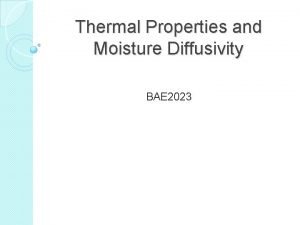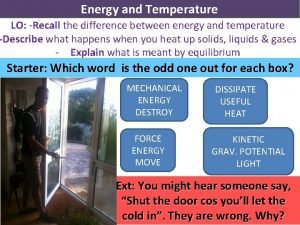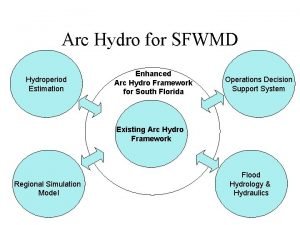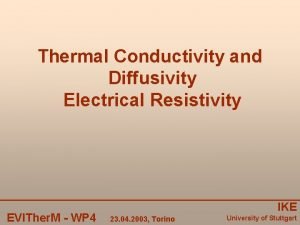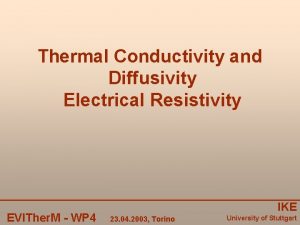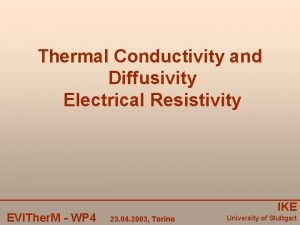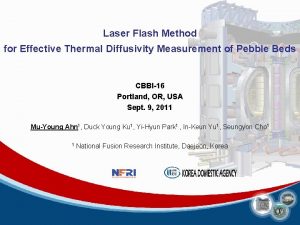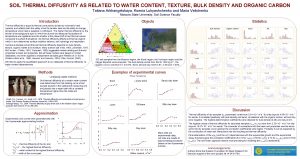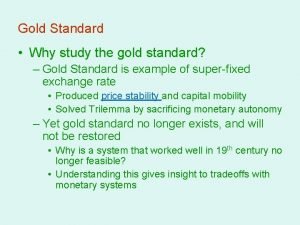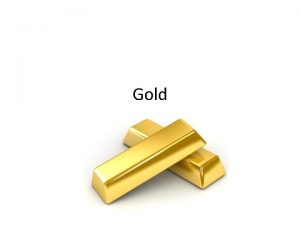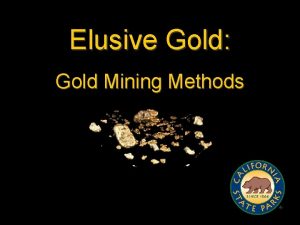Enhanced Thermal Diffusivity of Gold Nanofluid Measured Using












- Slides: 12

Enhanced Thermal Diffusivity of Gold Nanofluid Measured Using Mode-Matched Thermal-lens Technique Dr. Rajesh Kumar B Assistant Professor Department of Physics Nirmala College Muvattupuzha Kerala

Introduction Traditional heat transfer fluids such as water, oil and ethylene glycol are inherently poor heat transfer fluids. (thermal conductivity of water is 0. 6 W/m·K and for ethylene glycol 0. 235 W/m·K) In general, metals have high thermal conductivity (thermal conductivity of copper is 400 W/m·K). Suspending solid fine particles into the base fluid is expected to enhance thermal conductivity of that fluid The particles of micron size dimension suffer from sedimentation, fouling and clogging New technologies and new, advanced fluids with potential to improve thermal characteristics are of critical importance üNanofluids have a potential to reduce such problems EG-water mixture is widely used as a heat transfer fluid in, automobiles and heat exchangers Studied the effect of Au. NP concentration on thermal diffusivity values of mixtures, comprising ethylene glycol and an aqueous dispersion of Au. NPs. Measurements are also carried out for the corresponding concentrations of gold nanofluids alone Thermal diffusivity is a material property which determines how fast heat diffuses through a material 2

Sample Preparation The mixture for thermal diffusivity measurement is prepared by mixing equal amount of Au nanofluid and EG (50/50 volume ratio) In the mixture, concentration of the Au. NP is varied from 0. 7 to 3 n. M, to study the influence of NP concentration on thermal diffusivity value of the mixture 3

Thermal diffusivity measurement Setup 4

Thermal Diffusivity When thermal lens develops in the medium, if a probe beam is allowed to pass through thermal lens, the probe beam intensity decays according to the expression The parameter tc is called the characteristic time for thermal diffusion given by tc can be obtained by curve fitting the experimental data to the Equation (7) 5

Thermal Diffusivity The thermal diffusivity D of the unknown sample can be calculated using the expression In order to avoid the uncertainty in the measurement of beam radius, a reference sample, water, with known thermal diffusivity ( 1. 43 x 10 -7 m 2/s) is used to calculate thermal diffusivity of the unknown sample using the expression 6

TEM Studies TEM Image of Au. NPs HRTEM Image of an individual Au. NP. Inset shows the electron diffraction image of AUNP 7

Thermal Diffusivity Measurement The accuracy of the approach is measured by evaluating thermal diffusivity value of the organic liquids, EG and ethanol. The measured thermal diffusivity values (0. 917 ± 0. 005)x 10 -7 m 2 s-1 for EG and (0. 801 ± 0. 005)x 10 -7 m 2 s-1 for ethanol, agrees well with the earlier reported values The thermal diffusivity value of EG-water mixture (50/50 volume ratio) is also Thermal lens decay curve measured (1. 09 ± 0. 003)x 10 -7 m 2 s-1 8

In EG-Au nanofluid mixture the adsorbed charges are asymmetrically distributed on the surface of the particles These asymmetrically distributed charges will generate the dipole moment. Because of the dipole-dipole interaction, Au. NPs will assemble once thermal energy and the columbic repulsion are suppressed The integrative dipole moment of such assemblies of Au. NPs will exert a stronger attractive force, therefore causing chain growth. Thus, the pre-formed chains facilitate the addition of free colloidal particles to the end of the chains via the dipole-dipole attraction Thermal diffusivity of (a)Au nanofluid alone and (b) Au nanofluid-EG mixture 9

There is no separate NP in the TEM image indicating that NPs in the mixture prefer to aggregate The probability of aggregation increases with density of particles (concentration) in the mixture, as it reduces the inter-particle distance As a consequence, Au. NPs form linear or fractal configurations separated by large region of fluid pockets The formation longer chain like structures allows easy transport of thermal energy, which results in enhancement of thermal diffusivity values of the mixture compared to the gold nanofluids alone (a)TEM image and (b)HR-TEM image of Au. NPs in Au nanofluid-EG mixture 10

Thermal diffusivity values of ethylene glycol-gold nanofluid mixture is measured using thermal-lens technique The transmission electron microscopy images of the gold nanoparticles in the mixture clearly indicate the formation of chain like aggregates Such a chain like structure allows easy transport of thermal energy, which results in an enhancement of thermal diffusivity values of the mixture as compared to the gold nanofluids alone Given the importance of ethylene glycol-water mixture as a commonly employed heat transferring fluid, the present study where in heat transferring capability is measured in terms of thermal diffusivity have greater significance and practical applicability 11

Thank You 12
 Water latent heat of vaporization btu/lb
Water latent heat of vaporization btu/lb Thermal energy section 3 using thermal energy
Thermal energy section 3 using thermal energy Thermal energy is measured in ______.
Thermal energy is measured in ______. Thermal transfer vs direct thermal printing
Thermal transfer vs direct thermal printing A polygon is a closed figure formed
A polygon is a closed figure formed Price elasticity of supply formula
Price elasticity of supply formula Full base curls
Full base curls Buried in barstow enhanced edition
Buried in barstow enhanced edition Enhanced arc
Enhanced arc Technology enhanced items
Technology enhanced items Contoh eer diagram
Contoh eer diagram Enhanced disability management program
Enhanced disability management program Edma memory
Edma memory
